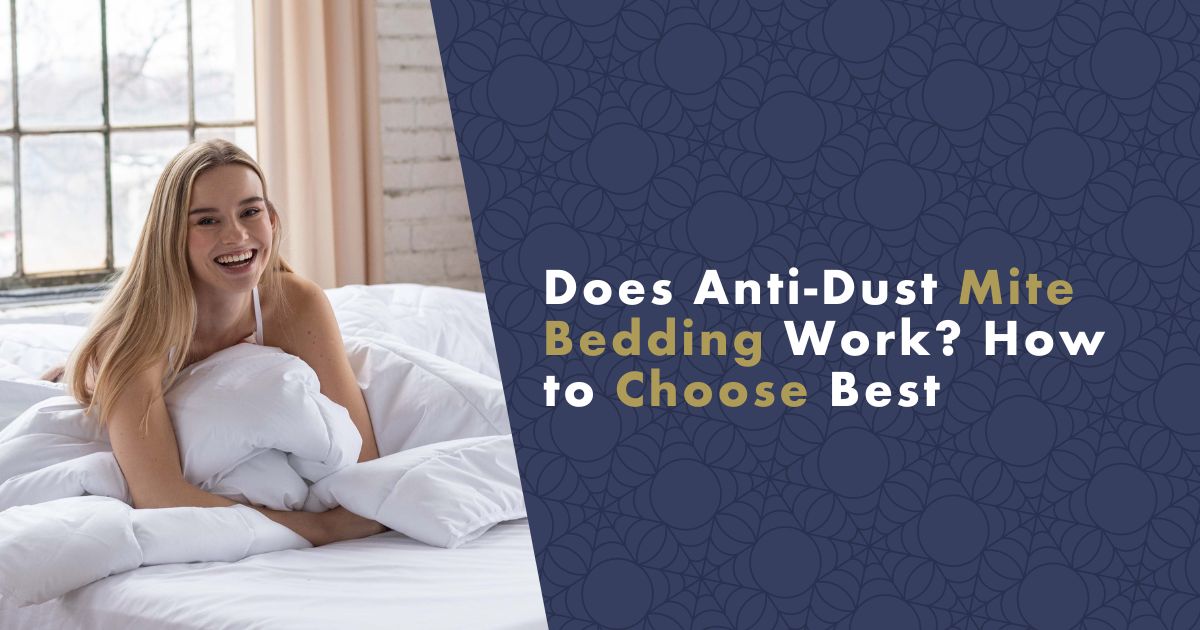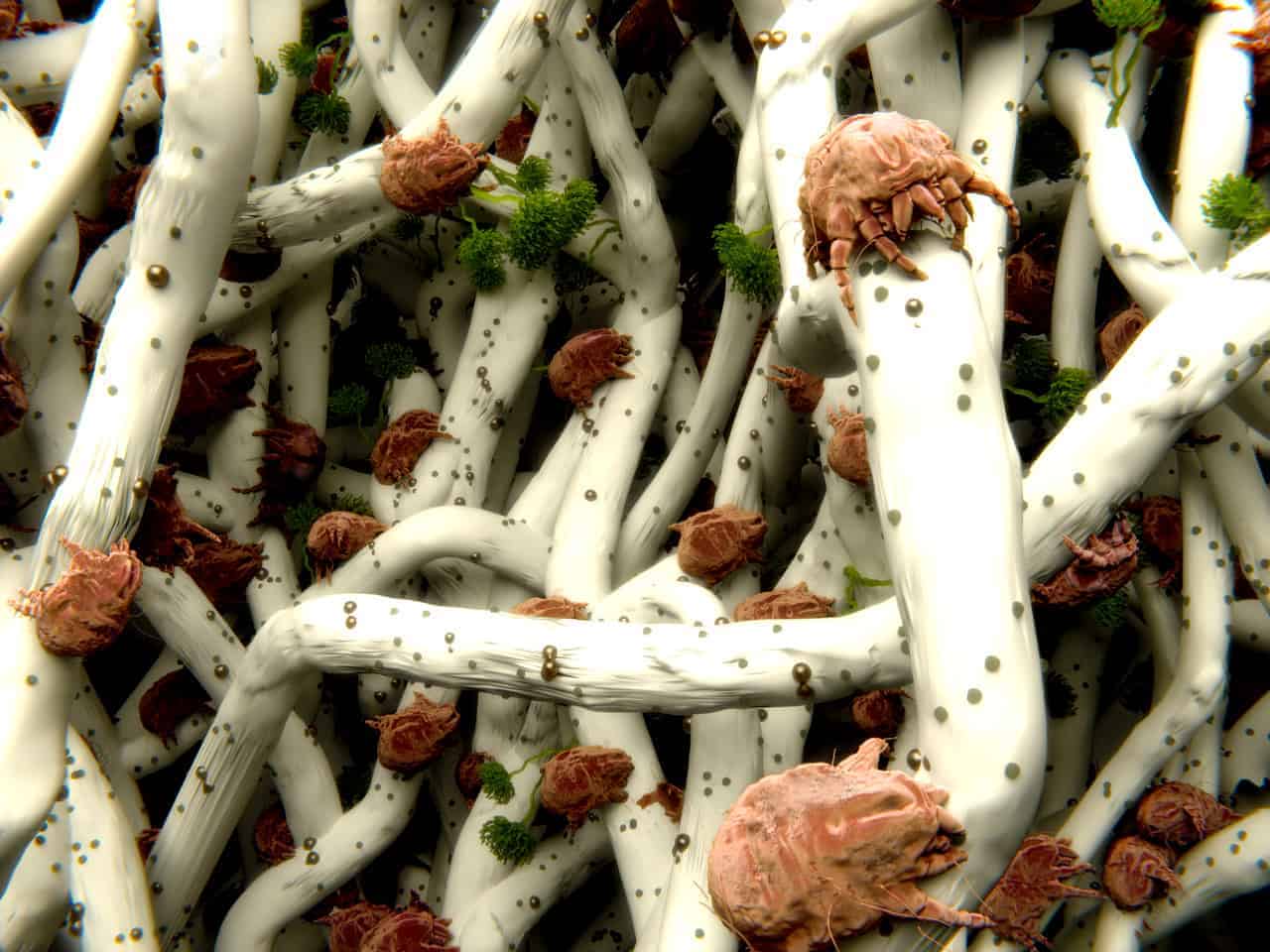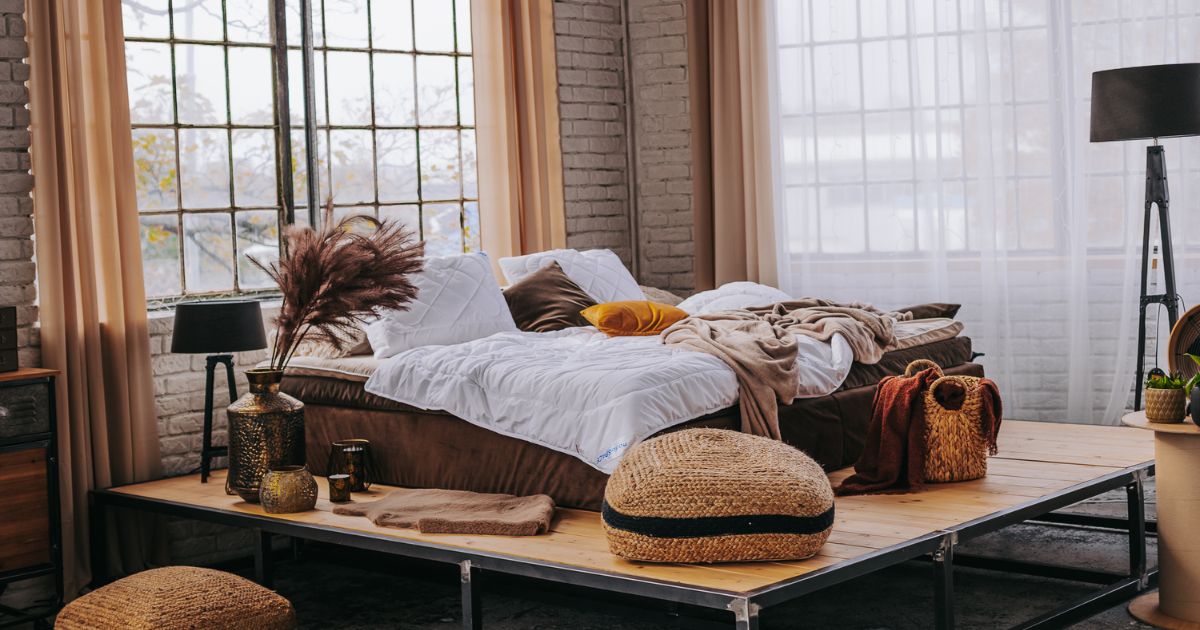Imagine sharing your bed with millions of invisible roommates every night. Dust mites hide in mattresses, pillows, and comforters, feeding on your dead skin cells and creating allergens that disrupt your sleep. For many people, this isn't just an unpleasant thought—it's a daily reality that affects their sleep quality and overall health.
Anti dust mite bedding represents a revolution in healthy sleep care. While traditional bedding simply provides dust mites with an ideal environment to live and multiply, modern bedding for allergy sufferers uses advanced technology to create a barrier that effectively blocks these microscopic pests. The right choice of dust mite proof bedding can mean the difference between restless nights filled with coughing and sneezing and peaceful, restorative sleep.

TL;DR
- Your mattress can contain 100,000 to 10 million dust mites - traditional bedding provides them with perfect shelter
- Nanofiber technology with 80nm pores blocks 99.9% of mites and their allergens - far more effective than regular 60°C washing
- Complete anti-allergenic systems include pillows, blankets, and bedding with nanofiber membrane for maximum protection
- nanoSPACE® products with OEKO-TEX® certification offer proven quality and safety for year-round use
- Investment in quality anti-dust mite bedding pays off long-term - longer lifespan, lower washing costs, better health
How do I know if my bed has dust mites?
If you're waking up with unexplained sneezing, congestion, or itchy eyes, your bed might be harboring millions of invisible guests. Dust mites are among the most common allergy triggers, affecting up to 85% of all allergy sufferers, yet they're completely invisible to the naked eye at just 0.1mm in size. The challenge isn't just that you can't see them—it's that they thrive in the exact conditions your bed naturally provides every night.
These microscopic relatives of ticks and spiders need warmth, moisture, darkness, and food to survive—everything the human body provides during sleep. Our body temperature gives them ideal conditions, while the dead skin cells we naturally shed become their main food source. During their 65-100 day lifespan, they produce up to 200 times their body weight in droppings, which contain the enzymes that trigger allergic reactions.
.jpg)
Read: How to Know if You Have Allergies: Signs and Symptoms
Since you can't spot dust mites directly, here are the telltale signs your bed has become their home:
- Allergy symptoms that worsen at night or upon waking: sneezing, runny nose, itchy eyes, or coughing that's worse in bed
- Age of your bedding: If your mattress is over 2 years old, it likely contains significant dust mite populations. Research shows dust mites can make up 10% of a pillow's weight after two years
- Bedroom environment: Warm, humid bedrooms (above 50% humidity) with poor ventilation create ideal conditions
- Worsening symptoms in winter: When windows are closed and humidity rises indoors
The reality is that virtually every home has dust mites - they're present in 84% of homes regardless of cleanliness. A typical mattress contains 100,000 to 10 million dust mites.
Dust Mite Bed: Why Your Bedroom a Dust Mite Paradise
Beyond just detecting their presence, understanding why bedrooms become dust mite headquarters reveals the scope of the problem. Your sleeping habits inadvertently create a five-star resort for these microscopic pests. Each night, you unknowingly provide room service through the 1.5 grams of dead skin cells you naturally shed, while your body heat maintains their preferred temperature zone of 98.6°F (37°C).
The eight-hour duration of sleep gives dust mites extended access to this perfect environment. Unlike other rooms where you move around frequently, bedrooms offer undisturbed darkness and consistent conditions that allow mite populations to establish and thrive. The moisture from your breath and perspiration creates the humidity levels they need to absorb water from the air—since dust mites don't actually drink water.
Anti dust mite bedding becomes essential when you realize that conventional materials actually compound the problem. Many products marketed as solutions inadvertently make things worse. Hollow fiber filling, despite being labeled "anti-allergenic" because it can be washed at high temperatures, creates a dust mite paradise with countless cavities that serve as protected nurseries for mite colonies.
.jpg)
Read: How to Choose the Best Anti Allergy Pillow for Allergy Sufferers?
What Fabric is Anti Dust Mite? Discover Revolutionary Nanofiber Technology
Modern nanofiber technology represents a breakthrough in dust mite proof bedding. The nanofiber membrane functions as a microscopic net with openings of only 80 nanometers. For comparison—a dust mite measures around 420,000 nanometers, its allergen 1,000 nanometers, bacteria 100-10,000 nanometers, and viruses around 100 nanometers.
This technology surpasses traditional approaches to bedding for allergy sufferers not only in effectiveness but also in maintaining breathability and comfort. Unlike densely woven barrier fabrics that often create an unpleasant "plastic bag" feeling, nanofiber membranes allow free passage of air and moisture while reliably blocking allergens.
How anti-dust mite bedding work?
The nanofiber membrane in anti dust mite bedding functions on the principle of a physical barrier with extremely small pores. Imagine it as a spider web with openings of only 80 nanometers. An oxygen molecule measures just 0.3 nanometers and can easily pass through fabric pores, keeping the material pleasantly breathable.
#produkty#https://www.nanospace.store/anti-dust-mite-covers/
The nanoSPACE® material is actually a three-layer laminate consisting of 100% polyester microfiber fabric weighing 90 g/m² on the face side, a nanofiber membrane in the middle, and 100% polyester knit weighing 50 g/m² on the reverse side. The microfiber and knit guarantee material softness and smoothness, while the nanofiber membrane acts as barrier fabric.
The Science Behind 99% Effectiveness
The effectiveness of nanofiber membranes was tested by the Textile Testing Institute in Brno for microorganism penetration and the Technical University in Liberec for penetration of 1μm dust particles. The State Health Institute in Prague tested skin tolerance and possible allergic reactions.

Read: Allergy to Dust: Symptoms and Treatment
Test results are impressive—effective capture of microorganisms ≥ 99.0% and effective capture of dust particles ≥ 99.9% were proven. No negative reactions in contact with human skin were demonstrated. These comparative test results from the Technical University of Liberec clearly show that nanofiber material outperforms other available woven and non-woven barrier fabrics in efficiency, breathability, and water vapor permeability.
Types of Anti Dust Mite Bedding Solutions
The anti dust mite bedding market offers several basic approaches to dust mite protection. Understanding the differences between individual solutions is essential for choosing products that best suit your needs and budget.
Basic categories include protective covers for existing bedding, complete anti-dust mite pillows and blankets with built-in nanofiber membranes, and specialized bedding with anti-allergenic properties. Each approach has advantages and suits different situations and user requirements.
Pillows vs Covers vs Complete Bedding Systems
Protective covers represent the most accessible entry into the world of dust mite proof bedding. These covers fit over existing pillows, duvets, and mattresses to create a barrier against mites. The main advantage is the ability to protect existing bedding without complete replacement.
_1.jpg)
Read: How to Choose Suitable Bed Linen for Allergy and Asthma Sufferers?
Complete anti-dust mite pillows and duvets with nanofiber membranes, such as anti-allergy pillows, offer integrated solutions. These products have nanofiber barriers built directly into their construction, ensuring maximum effectiveness and comfort. Unlike covers, they don't require additional layers, and you can use your favorite bedding on them.
Specialized bedding with anti-allergenic properties combines aesthetics with functionality. These systems often integrate nanofiber membranes with pleasant outer materials, creating elegant and effective solutions for the entire bed.
Summer vs All-Season Options
Seasonal needs play an important role in selecting bedding for allergy sufferers. Summer variants are designed with emphasis on maximum breathability and minimal weight. For example, our Ultralight Anti Allergy Duvet for Summer provides the same mite protection while maintaining a pleasant feeling during warm nights.
Year-round systems offer universal solutions with the possibility of combining different layers according to current needs. The advantage is long-term investment in one quality system covering all seasons. The disadvantage may be compromise in optimization for specific conditions of individual seasons.
Choosing the Right Anti Dust Mite Bedding for Your Needs
Selecting the right anti dust mite bedding depends on several factors, including allergy symptom severity, budget, material preferences, and aesthetic requirements. It's important to find balance between maximum protection, comfort, and practical use.
When choosing, consider bedding sizes, care and maintenance methods, quality and safety certifications, compatibility with existing bedroom equipment, and long-term costs including product lifespan. Quality dust mite proof bedding represents an investment that pays off both health-wise and economically.
.jpg)
Read also: Proper Pillow Washing Guide: Feather, Microfiber, and Hollow Fiber
Material Quality and Certifications to Look For
Material quality is the fundamental criterion when selecting bedding for allergy sufferers. Nanofiber membranes should have proven effectiveness through independent tests. It's important to verify specific percentages of mite and allergen capture—quality products achieve 99% or higher effectiveness.
Outer materials should be pleasant to touch, breathable, and easily maintainable. Microfiber fabrics offer optimal combination of softness and functionality. Material weight affects both comfort and durability—overly light materials may be fragile, while overly heavy ones may feel unpleasant.
Why OEKO-TEX Certification Matters
OEKO-TEX® STANDARD 100 certification is the gold standard for textile material safety. This certification guarantees products don't contain harmful substances that could threaten human health. For anti dust mite bedding, this certification is particularly important since products come into direct skin contact throughout the night.
#produkty#https://www.nanospace.store/anti-dust-mite-bedding/
OEKO-TEX® certification tests hundreds of harmful substances, including formaldehyde, pesticides, heavy metals, phthalates, and other chemical compounds. nanoSPACE® products with this certification provide assurance they're safe for all age categories, including children and people with sensitive skin.
Setting Up Your Complete Allergy-Free Bedroom
Effective dust mite protection requires a comprehensive approach to bedroom modification. Anti dust mite bedding is the cornerstone, but for maximum effect, you need to consider the entire sleep environment. Studies show most mites live in bedrooms, making it the best place to start modifications.
To protect mattresses, you can use anti-dust mite covers with nanofiber membranes or anti-dust mite bed sheets with nanofiber membranes. Millions of dust mites live in mattresses, so it's good to cover them with anti-dust mite covers or use anti-dust mite bed sheets.
Beyond Bedding – What Else Needs to Change
Besides dust mite proof bedding, it's important to modify other bedroom elements. Avoid wall-to-wall carpets, curtains, blinds, upholstered furniture, and traditional duvets and pillows in bedrooms. Use roller shades on windows instead of curtains.

► Read also: How to take care of the nanoSPACE® nano bedding.
What else helps allergy sufferers: optimal air humidity (bedroom humidity should not be less than 50%), high-quality air purifier with HEPA filter, and photocatalytic coatings that remove allergens from air. For people suffering from severe allergies or asthma, we recommend treating bedroom ceilings and possibly other rooms with FN NANO® self-cleaning coating, which eliminates allergens, bacteria, and viruses from air.
Maintenance and Care of Anti Dust Mite Bedding
Proper care of anti dust mite bedding is essential for maintaining effectiveness and extending lifespan. Unlike traditional bedding, products with nanofiber membranes don't require aggressive washing at high temperatures, saving energy, extending life, and reducing wear.
We recommend washing nanoSPACE® anti-dust mite pillows and duvets before first use (though not necessary). Wash without fabric softener at 40°C (104°F) for longer durability, or at 60°C (140°F) if necessary, using chlorine-free and phosphorus-free detergent or gel. Machine drying isn't recommended, even at low temperatures.
The advantage of quality bedding for allergy sufferers with nanofiber membranes is they don't need washing at 60°C or boiling since mites don't live in them. This extends bedding lifespan, allows more environmentally friendly washing, and is overall cheaper.
#produkty#https://www.nanospace.store/anti-dust-mite-linen-with-nanofiber/
Investment in Better Sleep and Health
Investment in quality anti dust mite bedding may seem like a significant financial expense at first glance, but long-term cost-benefit analysis shows it's an economically advantageous decision. Besides direct savings on medical costs and medications, quality anti-dust mite bedding brings several other financial benefits.
Traditional "anti-allergenic" bedding requires frequent washing at high temperatures, increasing energy and water consumption while shortening material lifespan. Dust mite proof bedding with nanofiber technology can be washed at lower temperatures, significantly reducing operating costs. Additionally, longer product lifespan means less frequent replacement and lower overall bedding costs.
Indirect benefits include better sleep quality, positively affecting work productivity, general health status, and quality of life. Many users report dramatic sleep improvement after just the first night using quality anti-dust mite bedding.
FAQ
How effective is anti-dust mite bedding compared to regular washing?
Regular washing at 60°C kills mites but doesn't prevent their return. Quality anti-dust mite bedding with nanofiber membranes provides permanent protection with 99.9% effectiveness in capturing mites and allergens. Additionally, it doesn't require aggressive high-temperature washing, saving energy and extending material life.
How do you get rid of dust mites in your bed?
Complete elimination is nearly impossible, but you can dramatically reduce populations. Immediate actions: wash bedding weekly in water at least 140°F (60°C) to kill mites, buy a dehumidifier to keep bedroom humidity below 50% and vacuum mattresses and pillows regularly with a HEPA filter vacuum.
Long-term solutions: Install anti-dust mite bedding with nanofiber barriers that physically block mites (99.9% effective), use allergen-proof mattress and pillow covers, replace carpeting with hard flooring and remove heavy curtains, replacing them with washable blinds.
Is it safe to sleep with dust mites?
For most people, sleeping with dust mites poses no immediate danger, but it's not optimal for health. For non-allergic individuals it`s generally safe, though prolonged exposure may eventually trigger sensitivities. About 15-20% of people will develop dust mite allergies over time. For allergic individuals dust mites can significantly impact sleep quality and overall health, may trigger asthma attacks requiring medical attention and chronic exposure leads to persistent inflammation.
Do dust mites bite you in bed?
No, dust mites do not bite humans. This is a common misconception. Dust mites feed exclusively on dead skin flakes that humans naturally shed. They live in bedding, not on human skin and they produce waste products (feces) that contain allergenic proteins.
Actual biting culprits in beds can be bed bugs (leave clustered bite marks, visible blood spots), fleas (small, itchy bites often around ankles) or other insects that may have gotten into bedding. If you're experiencing what feels like bites, examine for actual insects or consult a doctor to determine if it's an allergic reaction to dust mite allergens rather than bites.

